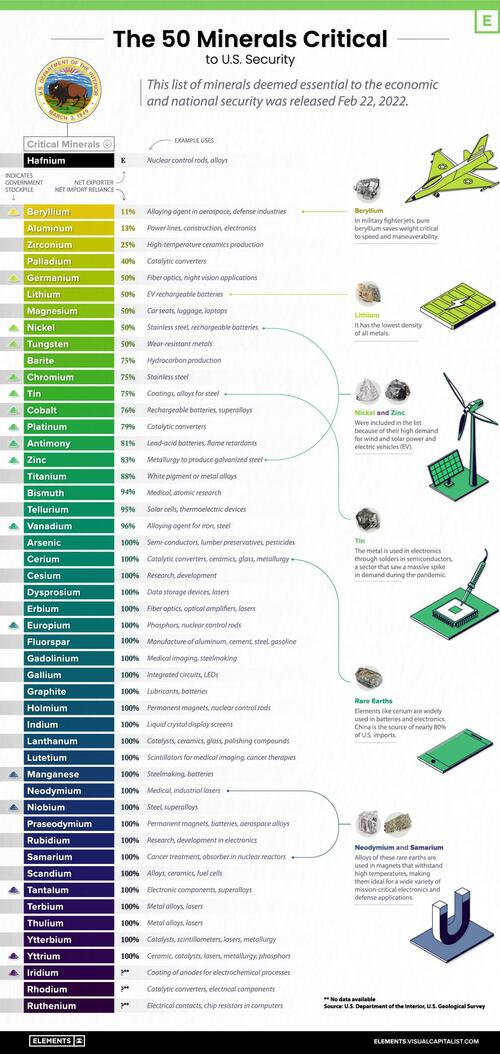See other World News Articles
Title: These Are The 50 Minerals Critical To US Security
Source:
[None]
URL Source: https://www.zerohedge.com/geopoliti ... -minerals-critical-us-security
Published: Mar 11, 2022
Author: Tyler Durden
Post Date: 2022-03-11 08:19:26 by Horse
Keywords: None
Views: 59
The U.S. aims to cut its greenhouse gas emissions in half by 2030 as part of its commitment to tackling climate change, but might be lacking the critical minerals needed to achieve its goals. The American green economy will rely on renewable sources of energy like wind and solar, along with the electrification of transportation. However, local production of the raw materials necessary to produce these technologies, including solar panels, wind turbines, and electric vehicles, is lacking. Understandably, this has raised concerns in Washington. In the graphic below, based on data from the U.S. Geological Survey, Visual Capitalist's Bruno Venditti lists all of the minerals that the government has deemed critical to both the economic and national security of the United States. What are Critical Minerals? A critical mineral is defined as a non-fuel material considered vital for the economic well-being of the world’s major and emerging economies, whose supply may be at risk. This can be due to geological scarcity, geopolitical issues, trade policy, or other factors. In 2018, the U.S. Department of the Interior released a list of 35 critical minerals. The new list, released in February 2022, contains 15 more commodities. Much of the increase in the new list is the result of splitting the rare earth elements and platinum group elements into individual entries rather than including them as “mineral groups.” In addition, the 2022 list of critical minerals adds nickel and zinc to the list while removing helium, potash, rhenium, and strontium. The challenge for the U.S. is that the local production of these raw materials is extremely limited. For instance, in 2021 there was only one operating nickel mine in the country, the Eagle mine in Michigan. The facility ships its concentrates abroad for refining and is scheduled to close in 2025. Likewise, the country only hosted one lithium mine, the Silver Peak Mine in Nevada. At the same time, most of the country’s supply of critical minerals depends on countries that have historically competed with America. China’s Dominance in Minerals Perhaps unsurprisingly, China is the single largest supply source of mineral commodities for the United States. Cesium, a critical metal used in a wide range of manufacturing, is one example. There are only three pegmatite mines in the world that can produce cesium, and all were controlled by Chinese companies in 2021. Furthermore, China refines nearly 90% of the world’s rare earths. Despite the name, these elements are abundant on the Earth’s crust and make up the majority of listed critical minerals. They are essential for a variety of products like EVs, advanced ceramics, computers, smartphones, wind turbines, monitors, and fiber optics. After China, the next largest source of mineral commodities to the United States has been Canada, which provided the United States with 16 different elements in 2021. The Rising Demand for Critical Minerals As the world’s clean energy transitions gather pace, demand for critical minerals is expected to grow quickly. According to the International Energy Association, the rise of low-carbon power generation is projected to triple mineral demand from this sector by 2040. The shift to a sustainable economy is important, and consequently, securing the critical minerals necessary for it is just as vital. Poster Comment: Are potash prices going up? Compared to September 2020 prices, ammonia has increased over 210%, liquid nitrogen has increased over 159%, urea is up 155%, and MAP has increased 125%, while DAP is up over 100% and potash has risen above 134%.
Post Comment Private Reply Ignore Thread